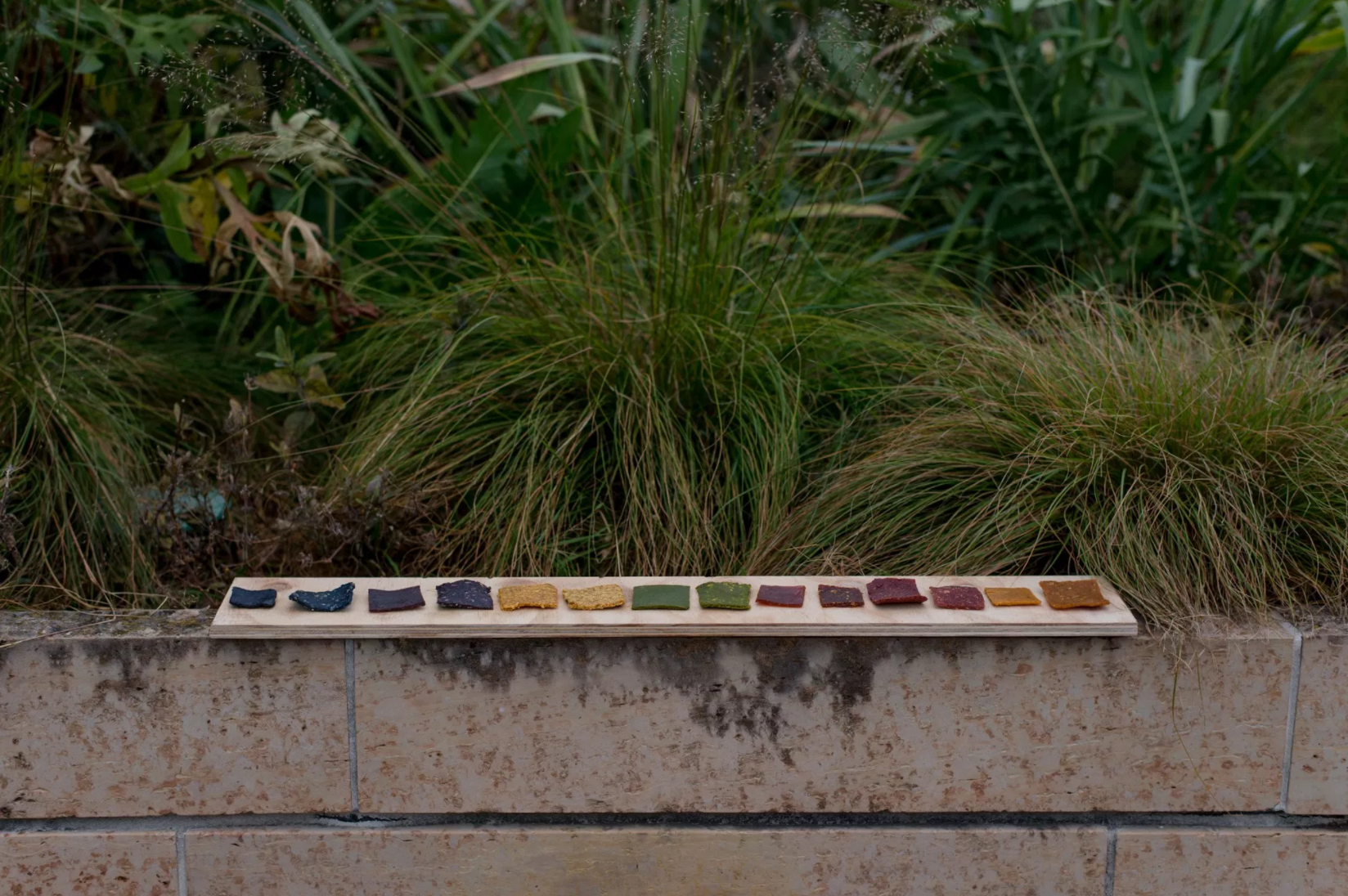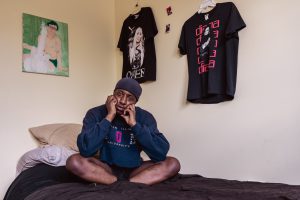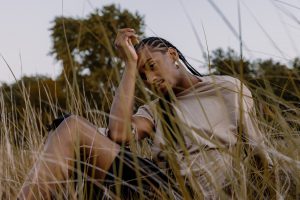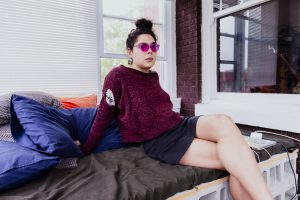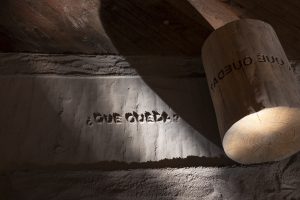As a designer who is concerned about the future of the planet, Jessica Gorse thinks sustainability is not a sufficient goal. If humans are to stem ongoing environmental and political crises, according to Gorse, they need to get more imaginative and take up regenerative projects that grow better future worlds. To that end, Gorse—who went back to school at age 28 for a degree in Designed Objects at SAIC—investigates the possible lifespans of materials we use every day. This takes form in her work with Fertile Design, a project she started with fellow SAIC students Erin Delaney and Soniya Khasgiwale. Together, they experiment with making plastics out of food waste that are then embedded with seeds and nutrient-rich natural dyes such that through biodegrading they replenish the soil and germinate.
What is so great about Gorses’s work is that it is both idealistic and completely practical. She calls this practice “futurist world-building.” When I met Gorse in her studio at SAIC, we began by watching two of her experimental video projects before digging into Fertile Design. “Fusion Vision” is a lo-fi cartoon music video featuring a guitar-plucking cob of corn singing the sad tale of a time when “Food was grown by chemicals/And often thrown away”—in other words, our current time. Then we watched an ad video for a speculative product called BITES, a trendy digital “hickey” that people wear on their necks to publicize their sexuality.
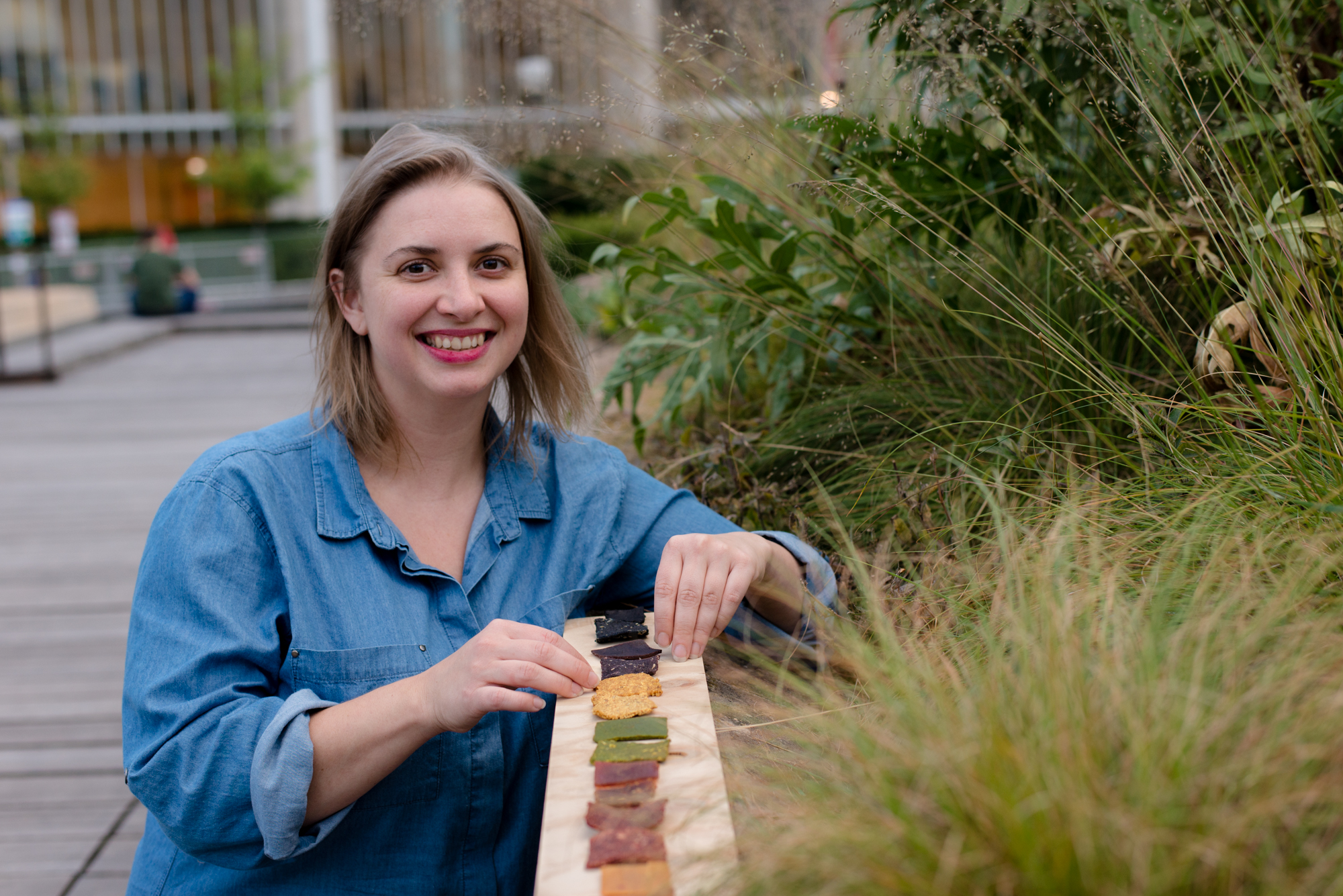
Sasha Tycko: I’m really excited to talk about the future with you. It’s really affecting to hear an old American-style folk song from the future talking about our present. What prompted these videos?
Jessica Gorse: So I took a class in future studies with Dr. Stuart Candy, he’s a leading futurist, and he taught us how to diegetically construct a world, creating a world in the future and looking microscopically at every detail. It’s kind of following this idea of, if you’re going to create futures and future world building, you create agency for people. If we can envision different possible futures, then we have agency in our present life. A lot of societies start to fail because they fail to imagine different possible futures. They just feel like, oh, the environment’s going to get ruined. But if you start to imagine these different futures where the earth isn’t ruined, then it gives agency to people in the present to act and do things that can transform the possible future they’re envisioning. And the way to create futures that people can actually put themselves and see themselves in is by creating these diegetic worlds, where you get to every possible detail and you use tropes that are common and relatable.
ST: Could you define diegetic?
JG: So for example, with “Fusion Vision,” I used the trope of the cartoon video and “School House Rock” to build my diegetic world. So I was using this trope that we’re really familiar with—it’s a kid video and it’s a cartoon, and you have the text that gets highlighted as the person sings. Another aspect of it is, in my future world, everyone has to garden, so most of our time is spent gardening. We still have the technology we had before, but we have less time to devote to it because we’re gardening all the time. So I created a diegetic prediction of how the quality would go down. We would still have ways to record music, but someone who’s recording this video doesn’t necessarily have the time to do a full recording. So that’s why the music [recording] quality is really bad, or the drawings and the cartoon are not the best quality.
ST: I’m familiar with the term applied to sound—like, “diegetic sound” in movies refers to the sound that comes from a source within the plot, as opposed to something like a voiceover or film score.
JG: Exactly. The process that we were doing was creating diegetic documentary films from the future. So, like, a sci-fi is a film about the future. We were creating films made in the future.
ST: Can you talk about Fertile Design and how you arrived at this point where you’re building objects for the future?
JG: The concept first began for me a year and a half ago, when I was working on a product that would be a fundraiser for the Cooperation Operation [a Southside community garden]. I was trying to create—well, you’ve seen paper seed pots that you can plant directly into the ground and the paper will slowly biodegrade. And I was thinking, how do you make that paper more beneficial to the soil? Paper itself is a carbon element… I was thinking about how when you make compost you have to have a balance between your carbon and nitrogen levels. I started to think about how I can add nitrogen levels to the paper so that it would actually feed the soil. So I started using beet juice as a dye for the paper, so that when the paper would break down, it would break down not only easier, but [it would] start to add nutrients to the soil.
Around that time I met Soniya Khasgiwale, who was getting her graduate degree in Designed Objects here at SAIC. We were doing similar things, but she was experimenting with polymers and using different starches. I think at the time she was using potato starch. So that was her carbon, and she was using coffee grounds as her nitrogen level. We started nerding out and talking about what we were doing . . . I found the EAGER grant through SAIC, a year-long research grant that’s awarded to students. So I asked her if she would want to apply with me, and that’s when I contacted Erin Delaney. Erin and I worked on the first year of Coop Op, and one of Erin’s big roles at there was working with seeds and I knew she was really great with bioremediation.
We started to think about, what if we made a polymer that was not only feeding the soil and biodegrading, but would also have seeds embedded in it that would start to suck toxins out? So we’re using a lot of plants that are native to Illinois and the Illinois prairie, and a lot of them can suck out iron. We have really high iron levels in Chicago because we’re a post-industrial city. So first the seeds break down and suck out the toxins, and then the polymer itself breaks down and starts to feed the soil. The third level of it was thinking of how to source that material. I started looking into closed-circuit system design, or closed-loop design—or cradle-to-cradle, as it’s also called. There’s a book called Cradle to Cradle [by William McDonough and Michael Braungart]. Cradle-to-cradle design looks into how you think of the beginning life of a product and also the end life of a product. [In most industries] right now we are on linear models for how we make materials; we extract them and turn them into products, and then we use them and dispose of them. I wanted to start to look at how we can close that loop. We started to look at the different industries in Chicago in particular and began to figure out how can we source their waste runoffs or feedstocks and start to make our material out of these waste streams.
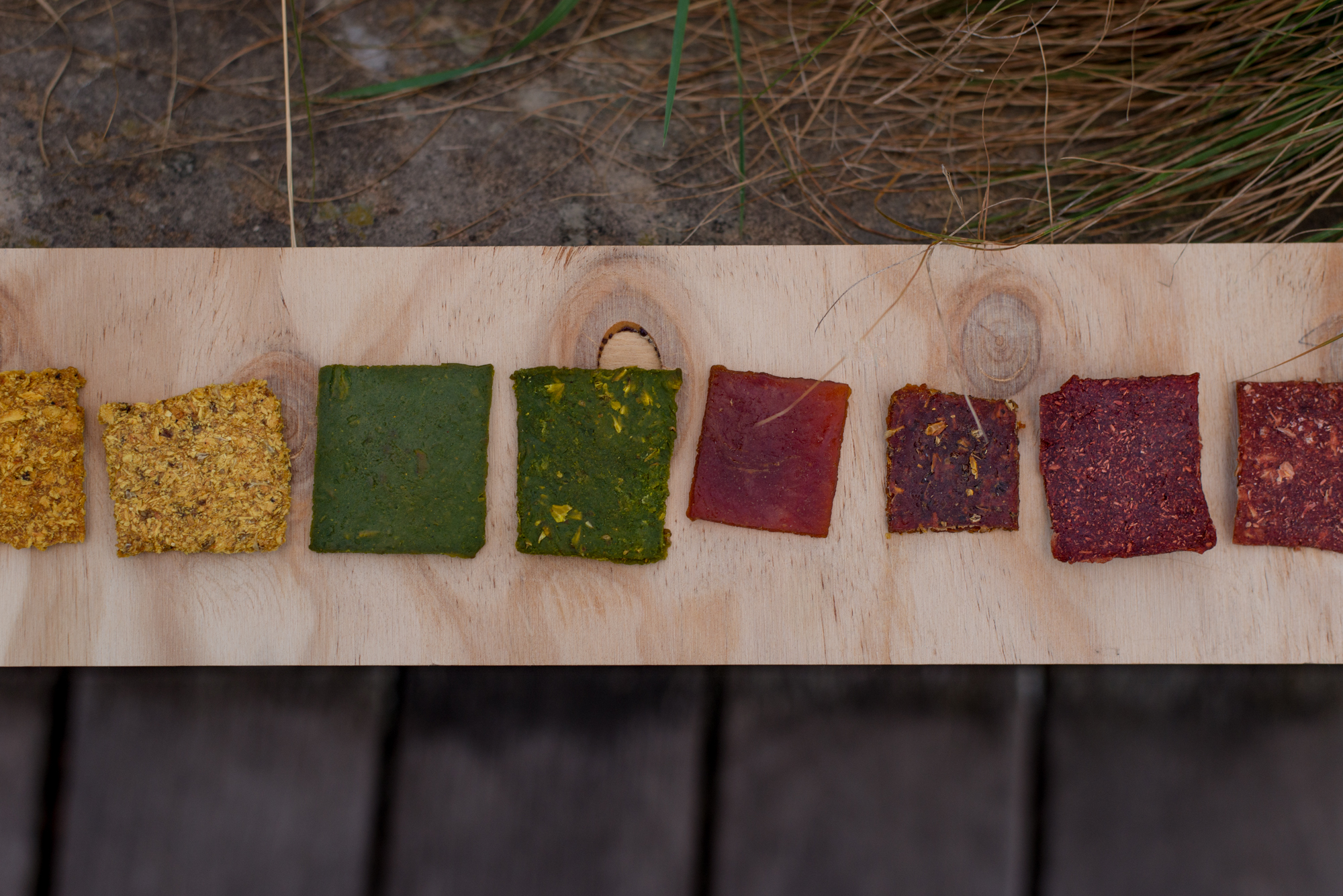
ST: What kind of business or industries did you work with?
JG: We’re mostly focused with the food industry. One of our first experiments was just going across the street [from SAIC] and working with the cafeteria to see if we could source their vegetables to start making our own potato starch. Then we started going bigger into the restaurant industry in Chicago.
ST: Just getting the food that’s thrown out?
JG: It’s two-part. Some of it is food that is thrown out and, unfortunately, what we ended up using was something that is cut off before it is wasted. It’s a sanitary version of the waste. Unfortunately, I can’t release what material we’re using because I have to get a patent pending before I can start to discuss the details.
ST: So where are you at now with these experiments?
JG: First, when we started making the polymers, we were really attacking it from an intuitive artistic process, where we would just take materials and experiment to see what would happen. A lot of the things we were making were flour-based and ended up a lot like ceramics. In the beginning, we were just intuitively mashing materials together. We were using aloe and pinto beans and just messing around. That wasn’t really yielding any successful results. So then we kind of backed up and started making biodegradable polymers that have already been discovered. At this stage of the process, we figured out really what a polymer is. We have everyday access to [polymers] like Tupperware, which is a synthetic polymer made out of oil compounds. A lot of our oil industry actually goes into making plastics. Do you want me to get into why plastic is so evil? That was a whole other area of research, too—just fully understanding what is wrong with plastic.
ST: Maybe the three sentence version.
JG: Plastics have a lot of fallacy that surround them. Something that I have learned recently is that our water bottles are only recycled once before they’re turned into leggings. Often times, materials are only recycled three times before they lose 73 percent of their material properties, meaning everything you know about that plastic—whether it’s hard or clear—is no longer there after only three recyclings. So it’s actually not being recycled. We also have to add in new polymers—new plastics—every time we recycle.
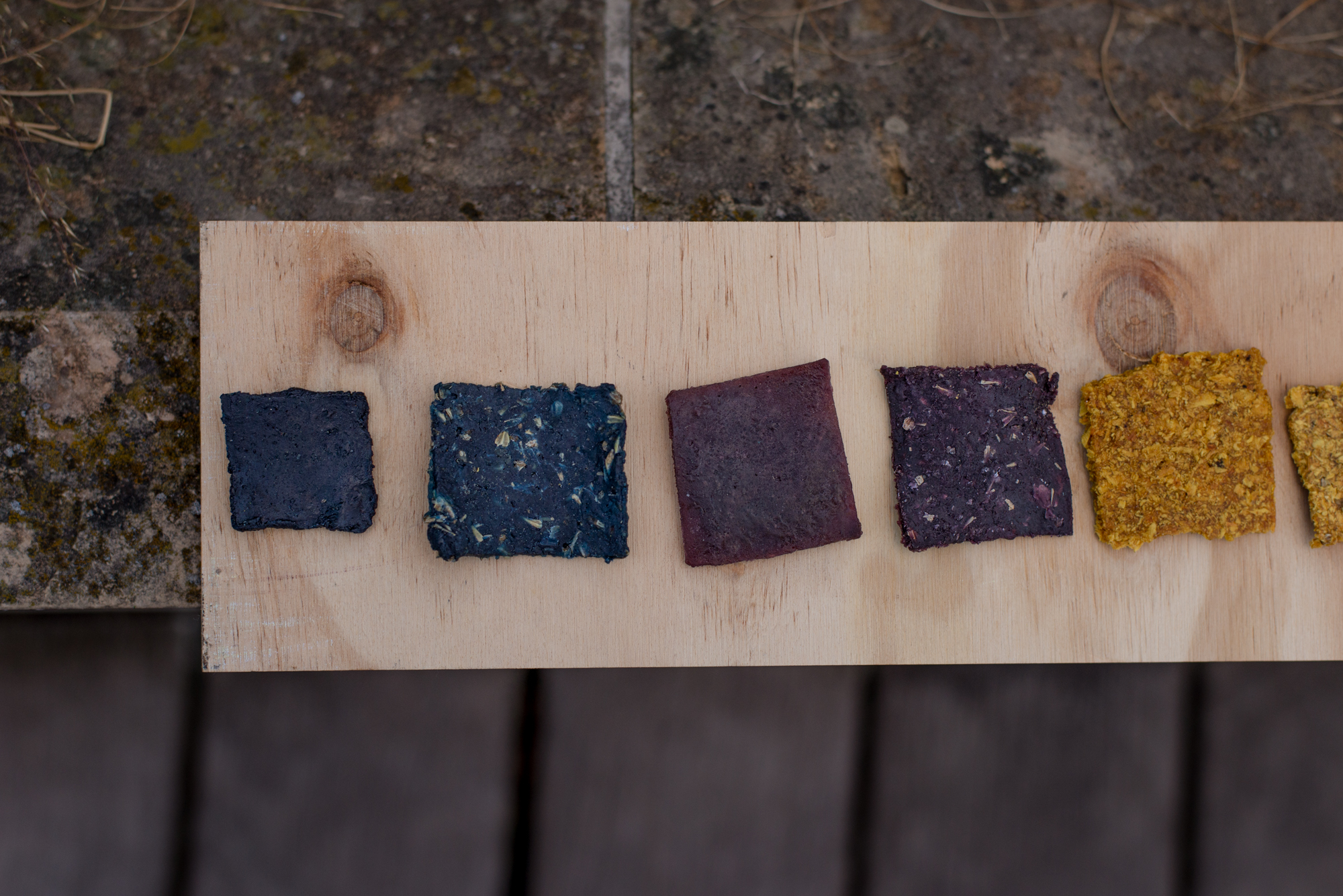
ST: What objects are you making now?
JG: Right now for my BFA show I’m working on making a garden pot out of the materials. In my family, at Christmas my dad gives all of us poinsettias and at Easter he gives us an iris or tulip. So I want to make pots to hold the poinsettias or the irises, so that we can continue this tradition. Once the poinsettia or the iris dies, you can take the pot and plant it in your backyard and have flowers throughout the summer.
ST: So what’s the vision for this project? Are you going to be working on this in a year or five years?
JG: Right now we’ve been working to figure out how we can get a patent so that we can start to talk more transparently about what our materials are made out of. However, we need funding because patents are pretty expensive. For this project, I kind of taught myself how to be a scientist, because I don’t have any science background besides high school chemistry. This has been really effective in being able to get us this far, but now we’re looking into different art and science grants to see if we can get linked up with a scientist as we get into trickier aspects of the material process. You have to figure out: how long does this plastic take to biodegrade in different situations? If you put this plastic in a cup of water, how water-soluble is it? How long does it take? Are there allergens attached to this product, since we’re using food waste?
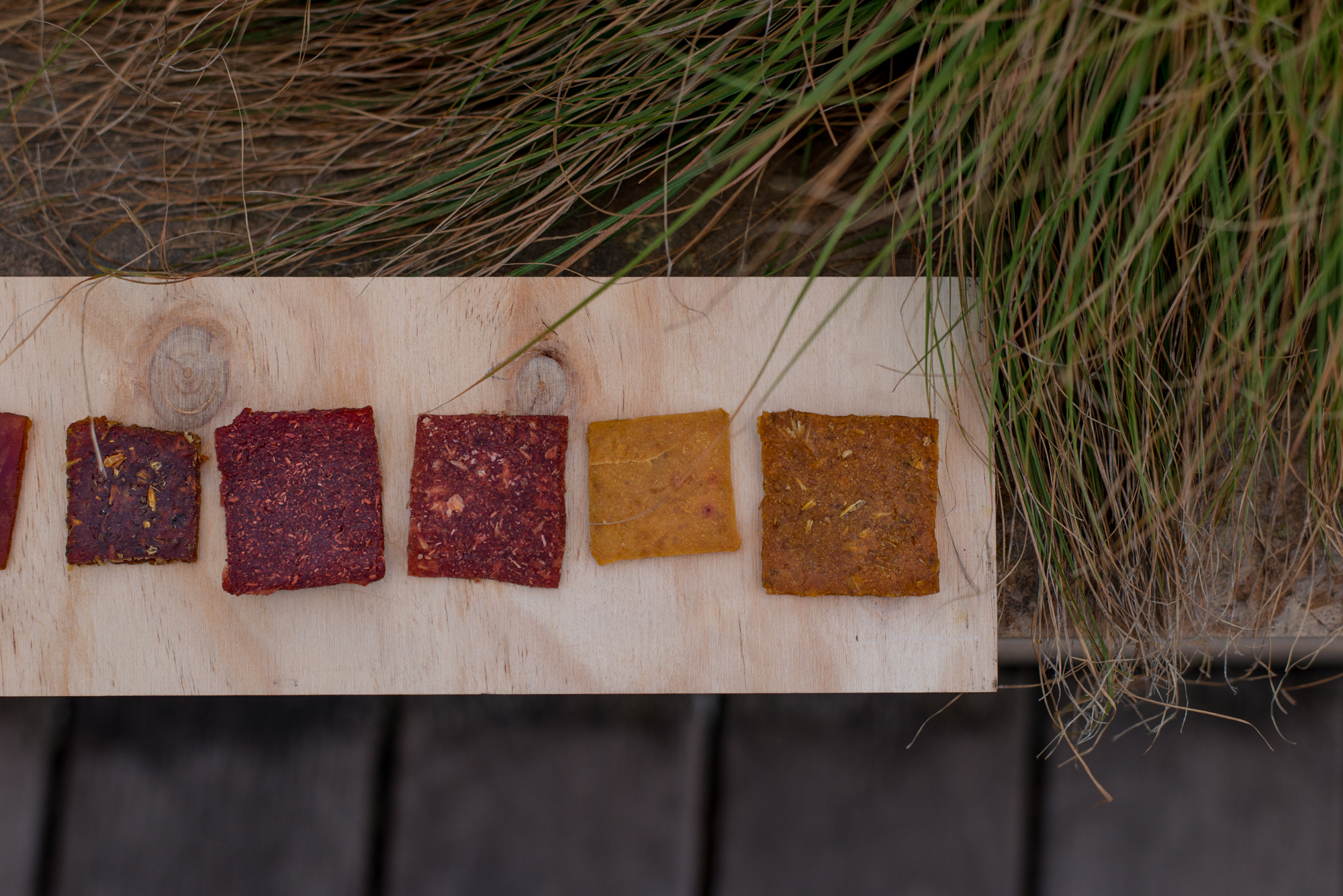
ST: At this point you’re a scientist, an entrepreneur, and an engineer. What about this is art for you? How are you as an artist approaching this project differently than someone who is approaching it as a scientist?
JG: Obviously, the aesthetic qualities of it. But I also think as an artist you think in a different way when you touch the material. Like, if I touch this [polymer] and it is really rubbery, what does that make me think of? I think you make connections in different ways [as an artist], because you are so tapped into aesthetic quality and social qualities. I think you target things differently when you look at colors or textures. And in a grander way, I think I look at the concept in a different way. I try to think of the beautiful process of making these materials. How does that start to transform the ways people use materials on an everyday basis and how do people think about materials? My art practice is really based in compassion, specifically for nature, people, and bridging together all of these different levels.
ST: How does the artist and the interactions between art and science build future worlds?
JG: Fertile Design in an exploration in innovation, and trying to innovate the way we see materials from their beginning to their end. This ties into my concepts of futurist or future world building. I think our daily acts build a future, whether it’s our personal future, just as waking up and going to school builds my future as a designer, or the future of generations, just as choosing to use more sustainable processes builds the future they’ll have.
There’s this short story by Ray Bradbury where he creates this whole trick on everyone by pretending to travel into the future and says, ‘The future is so wonderful. In 100 years we accomplish all this great stuff,” and he brings back all this quote-unquote evidence of that. Then everybody builds this future, because they’ve been told that this future is possible.
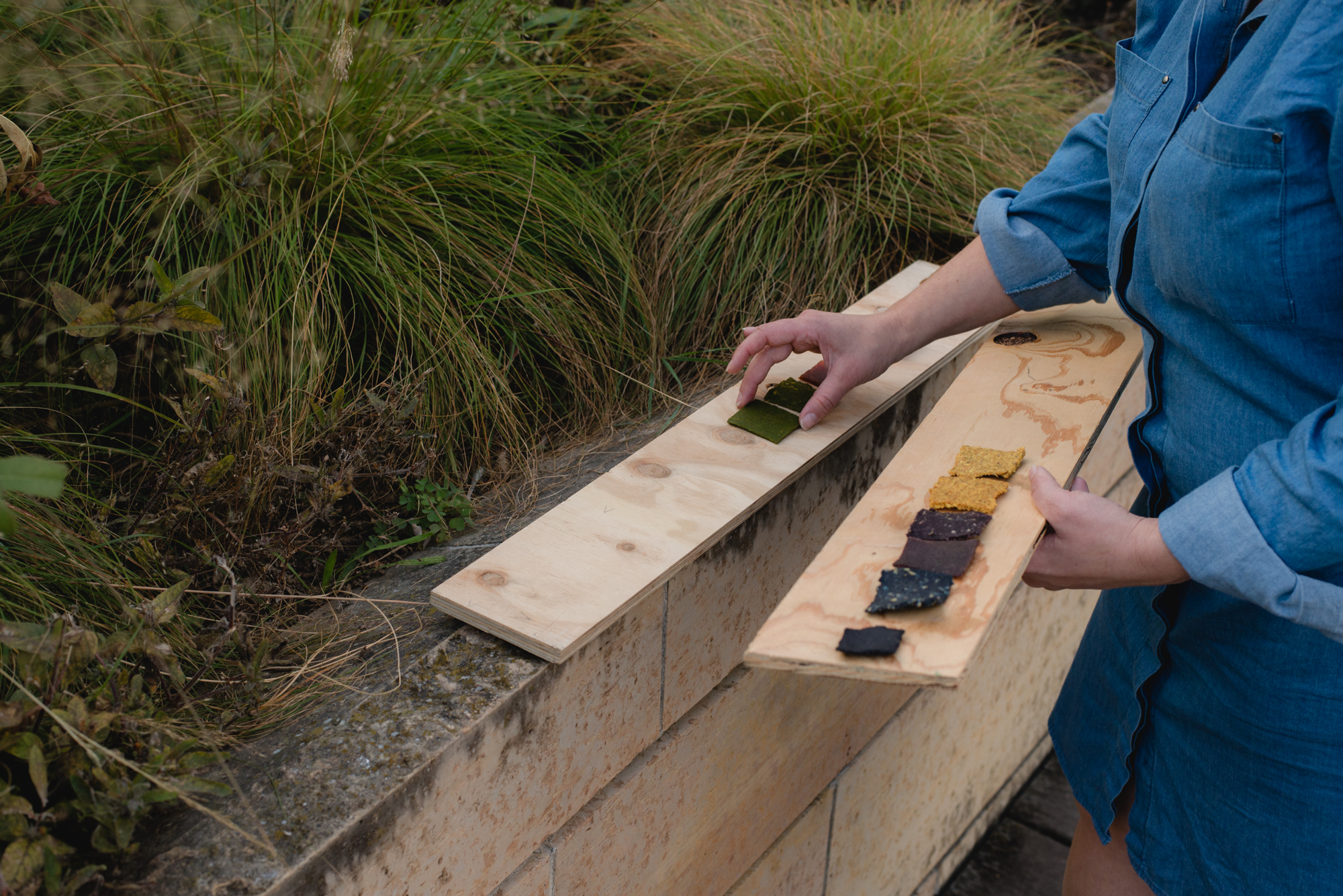
ST: So in your future, everyone is gardening. What else?
JG: Yeah, everyone’s gardening. Hmm, what else? BITES is an exploration in the acceptance of different sexualities; people being able to embrace the different forms in which they sexually express themselves. So it was an exploration in the fact that people don’t have to exist in gender binaries, and they also don’t have to live within a monogamous world or be afraid to express themselves as sexual creatures. Hmm…other ways I envision the future—I guess Florida not being under water. That’s a really scary prospect for me. My mother lives in Florida.
I think it’s important not to predict the future, because the future can’t be predicted, it can’t be locked down. It’s more like a forecast of the future. When you forecast the future you have to come up with multiple forecasts. I like working within models of like, okay, in ten years the environment’s in a really bad place, but then that is what causes all this change.
So I guess my future is more of a regenerative future, where we make it better. We talk a lot about sustainability, but we don’t want to sustain where we are—either culturally or environmentally. We don’t want to sustain, we want to regenerate, we want to change things and grow things.
Featured image: Samples of Fertile Design’s biodegradable plastics. The squares are arranged in a rainbow pattern going from purple, blue, and indigo on the left to orange, red, and yellow on the right. Photo by Ryan Thiel
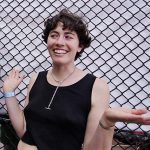 Starting from the proposition that art-making is world-making, Sasha Tycko combines community organizing and curatorial work with writing, music, and performance. Tycko is a founding editor of The Sick Muse zine and an administrator of the F12 Network, a DIY collective that addresses sexual violence in arts communities. Find more on IG: @t_cko and at www.nomoneynoborders.com. Photo by Julia Dratel.
Starting from the proposition that art-making is world-making, Sasha Tycko combines community organizing and curatorial work with writing, music, and performance. Tycko is a founding editor of The Sick Muse zine and an administrator of the F12 Network, a DIY collective that addresses sexual violence in arts communities. Find more on IG: @t_cko and at www.nomoneynoborders.com. Photo by Julia Dratel.
